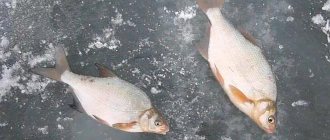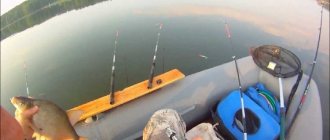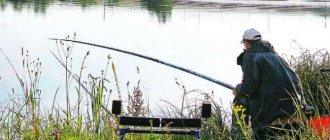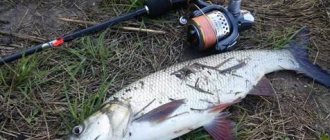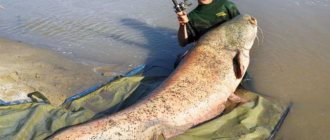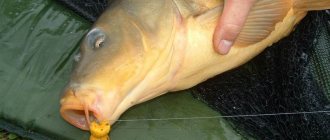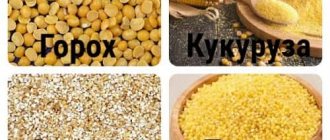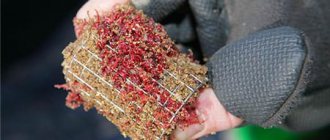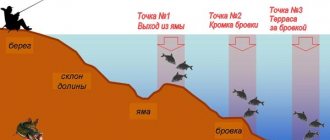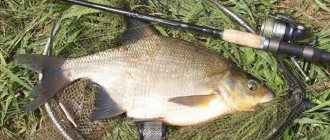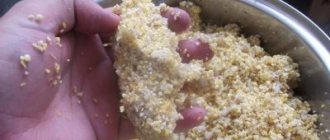Spawning time and spring fishing
Warts are a sign that the fish is preparing for the breeding process. Fishing begins as soon as the ice melts from the reservoirs.
A distinctive feature is that the bream feeds constantly at these moments, without taking breaks like some other species. Gradually, with the onset of warming, the bite intensifies, reaching a maximum (the water at this moment is 12-14 degrees). After this, preparations for the spawning period begin (water is about 15 degrees), the bite can be unpredictable. When the water temperature reaches 16 degrees, spawning begins. The bite subsides and lasts for 4-7 days, depending on the weather.
In case of good and stable weather conditions, without cold snaps, a maximum of 1 week is sufficient. If nature turns on the whims, then the process may drag on a little until the water temperature rises again to at least 16 degrees.
As soon as the spawn passes, the bream returns to the shore again, moving on to the next phase of feeding. This period of time is called post-spawning, it lasts for a week. After a week, he moves away from the shore in search of holes, and having found a suitable place, he remains there throughout the summer.
When to catch bream in spring

As mentioned above, bream fishing in the spring begins as soon as the reservoirs are free of ice. Ice melts around the end of March and beginning of April. But at first, the bream bite is not particularly stable and periodically there may be a surge or a complete absence of bite.
When the water in the reservoir becomes more transparent and warm, the activity and stability of the bream's bite increases. And by May, bream biting activity reaches its peak and you can observe its pre-spawning feast. In May, you can successfully catch bream almost every day, and the catch of experienced fishermen during this period is usually the largest, compared to other times of the year.
But spring bream rarely indulge in large sizes. Usually there are small bream and white bream up to 1 kg. Large bream will come later, at the beginning of summer. And in the spring there is an opportunity to actively catch bream that are preparing for spawning, which after a long winter break will be a very interesting activity.
In spring, you can start catching bream from early morning until sunset. But bream is most active at lunchtime, when there is an opportunity to pamper itself with the long-awaited rays of the sun in shallow water. At night, bream is also not averse to eating bait, but still cold water makes itself felt and night spring bream is inactive.
Bream habitats during the day
Relying on the information above, you can now imagine a map of fish movements and identify potentially catchy points. Now all that remains is to figure out where the fish are most likely to be depending on the time of day.
In order not to be tied to a date or a specific time, remember that everything depends on the water temperature, which can vary from year to year depending on the month. But what remains unchanged is at what approximate water temperature spawning and feeding begin (degrees are written above).
The cooler it is, the farther from the shore the bream stays and vice versa: the warmer it is, the closer it is worth looking for.
- In the morning , in clear weather, it is worth starting your search from the coastal zone, fishing in areas 1.5-2 meters deep. The water in these places begins to warm up first, so these are the best places for fishing.
- During the day , look for shallows where it is also warm, since the water is still cool at depth. There are almost no bream near the shore, since this is a rather cautious fish, it stays at a distance.
- In the evening, the search should begin from the coastal area, where there is at least some vegetation (even if it is reeds or driftwood). Let us remind you that spawning is approaching, and the fish are looking for places to spawn.
- At night, the wary bream migrates again to the shallows to search for food. Fishermen have noticed that during the full moon and the absence of clouds, the bite improves. Most likely this is due to the fact that in the moonlight it is easier for him to see and find food at the bottom, so he can peck much better. The larger the individual, the more cautious it behaves, regardless of the time of day or night, so now is the most favorable time to catch a trophy.
Fishing methods
The methods do not differ radically from the summer or spring periods, remaining unchanged. Bream travel in schools and feed from the bottom, so the methods will be selected accordingly. Which one you choose will depend on the equipment method and approach, but it’s difficult to say that one of them is much better. The choice depends on experience or fishing conditions.
On a float rod
When it comes to float fishing, a long rod wins; a 6-7 meter blank will be just right. A 5 m fishing rod is more versatile.
Rod equipment:
- The main line is 0.20-0.25 mm.
- Leash with a diameter of 0.12-0.15 mm. The material is monofilament or fluorocarbon.
- The reel can be either inertial or inertial-free; the first option is preferable, since this is not a feeder rod and there will be no long casts.
- Hooks are used in sizes from 8-14, in rare cases they knit something larger, in No. 6.
- The distance is selected experimentally, but casting too close is also not worth it.
To the feeder
The feeder is the most common method of spring bream fishing, as it allows long casting and fishing from the bottom. Used in currents and in still water. From April to October, you can use this method without hesitation, since during this entire time it does not lose its relevance.
Having equipped the rod with a marker weight, find promising places - these will be shallows further from the shore, where the water temperature will be higher compared to the holes. Afterwards, 5-6 casts of bait are made (full feeders) to create a feeding spot.
This will allow you to lure fish to the fishing point by smell, as well as keep them in one place. In order for this to be feeder fishing and not donk fishing, casts must be made in exactly one place. To do this, immediately after finding the place, place an elastic band on the reel, securing it to the eye of the reel, and also find a landmark on the opposite bank.
Next, placing the feeder behind your back, aim at a landmark while casting. The rubber band on the reel will not allow you to unwind excess line, so you will place the feeder exactly on target. It is necessary to transfer the tackle a maximum of every 10 minutes, checking the bait and filling the feeder with a new portion of bait. If there is no bite for a long time, then you need to experiment with baits.
On the donk
Donka is a simplified version of a feeder rod. When using it, very often there is not even a fishing rod - all the gear is tied to a wooden block. There are a lot of installations, some of them using a feeder, some without it. The main line is quite thick (0.25-0.30 mm) - its diameter is not critical.
The length and diameter of the leashes are much more important. The more capricious the bite and the stronger the current, the longer the leash is knitted. We advise you to start with leashes from 0.5 m, gradually increasing its length in the absence of a bite. The same applies to the feeder, where the conditions for the size of gear are no different.
The hook size also does not differ from fishing with a float. It is advisable to pre-fed the place to attract bream. For bait, use a worm, bloodworm, maggot, sandwich (a combination of several types of bait). Read more about donka fishing
Universal equipment
Suitable for any type of fishing and rod, using the following recommendations you definitely can’t go wrong:
- Fishing line or braided cord - it doesn't matter to anyone. Line with a diameter of 0.20-0.25 mm, braid 0.10-0.12 mm.
- The leash should always be thinner and more delicate than the main line. A diameter of 0.12-0.16 mm is sufficient.
- It is advisable to select hooks depending on the bait. For a worm, a long forend is preferable. Color doesn't matter. Size from 8-14 rooms.
- The rod does not matter, especially for a novice fisherman. You can fish with either a bamboo fishing rod or a twig made from bushes. Much more important is fine equipment, the right bait and bait.
- For the shore, a long rod is desirable. In this case, size will always be a plus: feeder 2.7-3 m, float 5-7 meters.
- If you have a boat, read about catching bream with onboard fishing rods
Lure
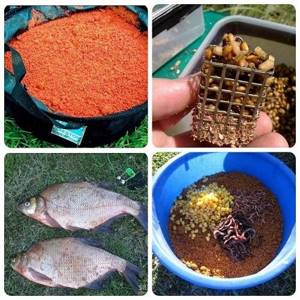
When it comes to bait, everyone can do what they can, but there are constant ingredients used by everyone and not only in the spring. This can be either a purchased ready-made option or one made at home. One of the recipe options:
- Vanilla sugar
- Sunflower oil
- Pearl barley and wheat porridge
This is not the final version yet. Next, having purchased a basic, ready-made bait, mix all the ingredients. The recipe is considered one of the best in spring fishing, perfectly attracting not only bream, but also rudd, silver bream, and roach.
Second homemade recipe:
- Wheat bran (1 part)
- Oatmeal (add a little at a time to achieve desired viscosity)
- Breadcrumbs (3 parts)
- Cookies (1 part)
- Corn, pre-shredded (1 part)
- Sunflower seeds, roasted (1 part)
Breadcrumbs have a beneficial effect: when they fall into water, they create a cloud of turbidity. It is this turbidity or dust in the form of a cloud that attracts fish. And by adding chopped worms or bloodworms to your bait, you will keep the bream in the fishing spot for a long time.
Don't forget a few important principles :
- Don't overfeed your fish. You should not throw the feeder very often or very much with large fractions. Having eaten, the bream will simply leave the place.
- What you will use as bait must be present in the bait. To highlight it, use dips (chocolate flavor, tutti-frutti, vanilla).
It’s worth taking a closer look at flavors and dips. At first, try not to use any odors; it is quite possible that spring bream is still wary of strong odors.
Only in case of long pauses in the bite should something be changed in the bait. This is where dips come to the rescue - cans with a spray and with different smells, making it possible to distinguish the bait from the rest of the food on the bottom.
Tasty and sweet smells will be just right:
- Cherry
- Vanilla
- Caramel
- Chocolate
- Cinnamon
- Strawberry
All of them are used in the summer, under the same conditions, so be sure to take 3-4 dips. But remember to use it carefully. It is enough to spray the bait 1-2 times for it to start working in a new way.
☸ Feeding bream
As already mentioned, bream reacts to bait from the very beginning of fishing in open water. The basic rule in using bait is to do no harm. The fish may be frightened by the noise of heavy balls falling into the water, the excessively strong smell of one of the components, and finally, it can simply be overfed.
After discovering a bream camp, you should try to catch without bait and use it only if the bite weakens. The mixture should be served in small portions and not too often, so that the place “rests”. The so-called feeding, which feeders practice in the summer, often has the opposite effect in the spring. It, of course, collects fish at the point, but a worm or pearl barley on a hook no longer arouses interest in it.
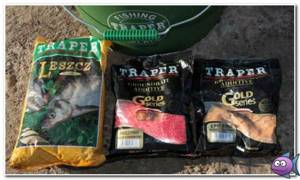
To feed bream, the easiest way is to purchase a store-bought mixture. If this is the first half of spring, then the packaging must indicate: “For cold water.” The bait can also be prepared independently from available ingredients: corn grits, pearl barley, breadcrumbs, milk powder, sunflower cake, dry semi-finished products, cookies, and so on. Directly at the reservoir, you should definitely add any animal component to it - food bloodworms, crushed worms or a handful of maggots.
What baits are used
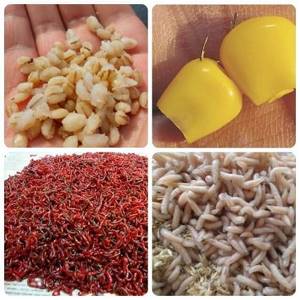
One of the deciding factors when choosing bait in the spring is water temperature. Before and after spawning, the bream fattens up and live bait is best suited for these purposes:
- Bloodworm
- Worm
- Maggot
- Caddisfly (larva)
- Dragonfly larva
Closer to May, when the water warms up sufficiently, you can gradually switch to vegetable and other baits:
- Corn
- Pearl barley
- Semolina
- Dough
- Boyles
- Styrofoam
It is not necessary to use 1 type of bait on the hook. Sandwich (using several types at once) gives excellent results. If there is no bite for a bunch of worms or a couple of maggots, try combining them: use a worm with maggots, or bloodworms with pearl barley.
All types of bait listed above - live and vegetable - are used not only in the spring, but all year round. When bream is picky, experiments should be carried out with bait or groundbait. Don’t forget to try dip if there is no bite for a long time - it can save the situation.
What to use to catch bream in spring
Bream can be caught using both animal and plant baits. But you must remember one rule:
While the water is cold, any fish, including bream, prefer animal baits that are rich in protein, which is so necessary for the fish to restore strength after winter. Vegetable baits will be more effective in the summer when the water warms up well.
Thus, you can immediately determine the priority baits that should be used in the spring for catching bream:
- worm;
- bloodworm;
- maggot;
- bark beetle
Combinations of baits, so-called sandwiches, can work well. Sometimes bream does not bite on a worm or maggot, but if you put both baits on one hook, the bite will become more active. In each reservoir, the taste preferences of bream can vary significantly, so try baits both individually and in combination.
But still, just before spawning, when the water has warmed up enough, you can try vegetable baits:
- dough;
- bread;
- corn;
- pearl barley;
- mastyrka;
- semolina.
It is advisable to use bait elements in bait. That is, if you are fishing with a worm, add a little chopped worm to the bait, the same when fishing with bloodworms.
